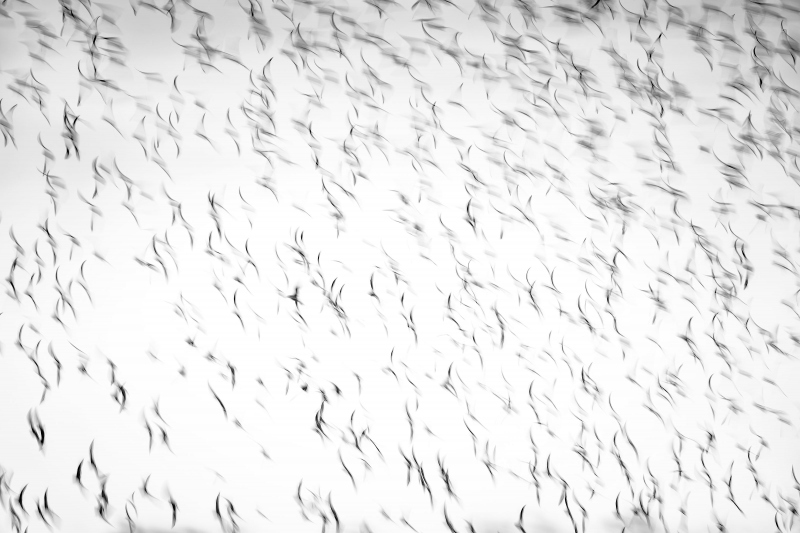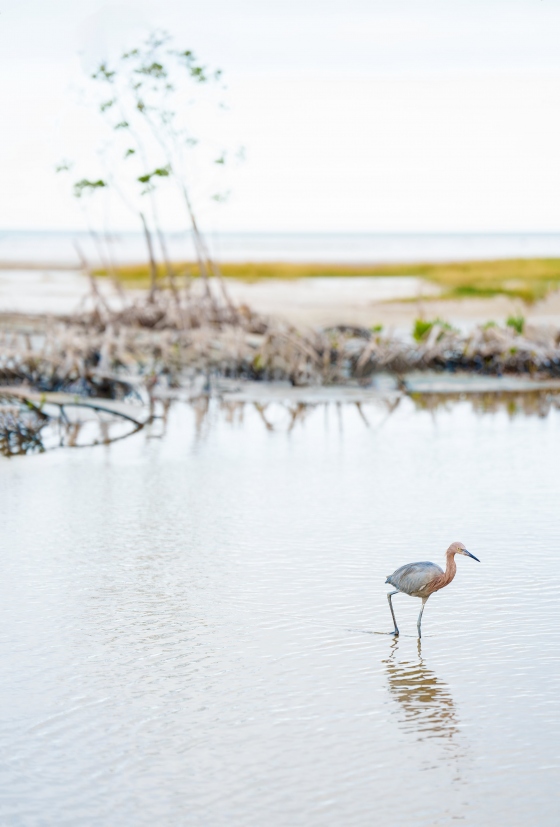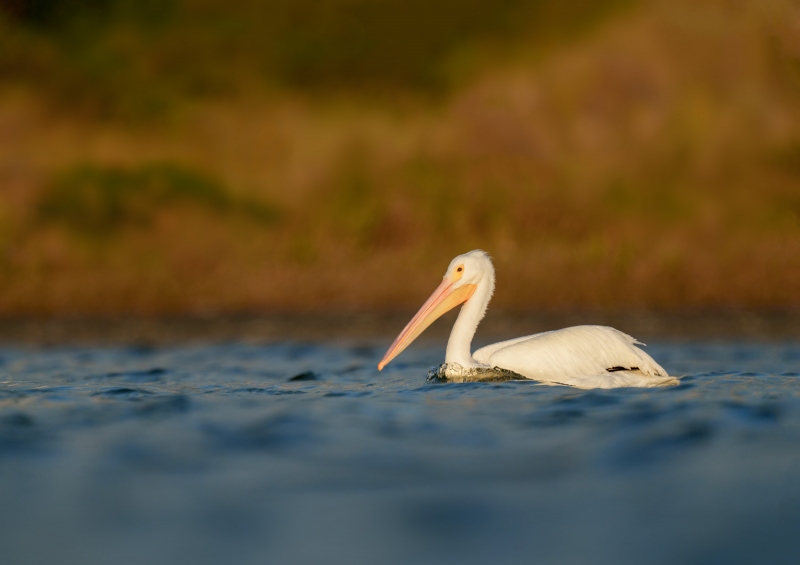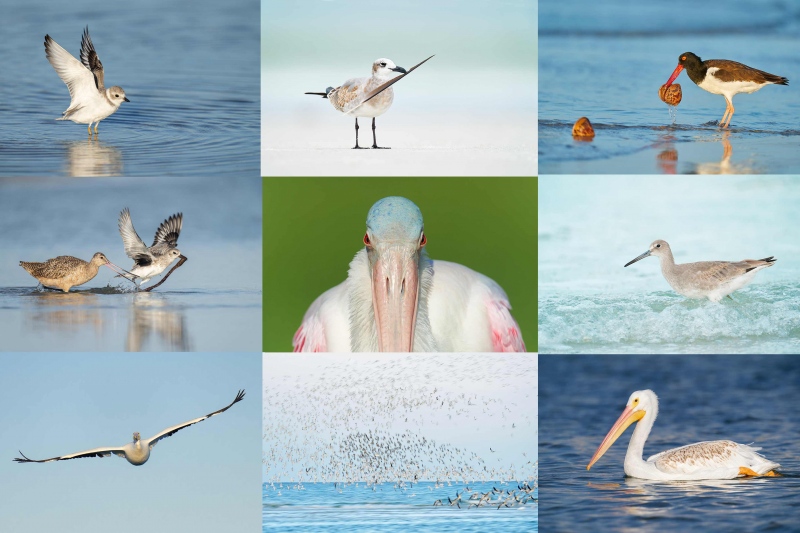Your Call?
Which of today’s three and completely different featured images do you like best? Please leave a comment and let us know why you made your choice. And while you are at it, take a crack at the Multiple Choice/Fill-in questions.
My Call
In the last blog post, Flying High in the Galapagos, here, I felt that all the images were very strong. My least favorite, however, was the top shot of the young Swallow-tailed Gull. Why? Just a few minutes before I had fanned on a great dorsal view flight chance of an even handsomer juvie of the same species. Most popular was Image #2, the Hood Mockingbird in flight. While I loved that one, and did have something to do with its creation, most of the credit has to go to the Sony 400mm f/2.8 GM lens and the a-1; Face-Eye AF is beyond incredible with this rig — super-fast initial AF acquisition and amazingly accurate eye-tracking.
My very favorite image, also made with the 400mm f/2.8, was Image #1, Waved Albatross on final approach with landing gear down. Why? It has been very difficult over the decades to create a flight shot of this species that excited me — they usually just glide on by with nary a flap. With this bird’s landing gear down, the tail fanned, and the braking-to-land wing position, this one was very satisfying.
What’s Up?
I was thrilled to learn this week that newbies Alan Goodwin and Paul Marbourg will be joining many multiple IPT veteran John Dupps and me on the fourth DeSoto IPT. There are still three spots open on that one and IPTs #2 and #3 (scroll down for details) are wide open, assuring you of a private or near private IPT experience. In addition, be sure to check out the two Used Gear Page bargains immediately below.
This blog post took about two hours to create (including the time spent on the three image optimizations). 4085 published posts are nothing to sneeze at.
Today is Monday 18 September 2023 and I still have lots of work to do. As soon as I hit Publish, I will get back to answering e-mails and dealing with greedy, uncaring corporations and like Fed-Ex and shyster mail order companies. Wish me luck. Have you been scammed, cheated, or screwed over lately? Feel free to leave a comment and vent.
Wherever you are an whatever you are doing, I hope that you too have a great day.
Please remember to use the B&H and Amazon links that are found on most blog pages and to use the BIRDSASART discount code at checkout when purchasing your new gear from Bedfords to get 3% back on your credit card and enjoy free second-day air FedEx. Please, also, consider joining a BAA IPT. You will be amazed at how much you will learn!
You can find some great photo accessories (and necessities, like surf booties!) on Amazon by clicking on the Stuff tab on the orange/yellow menu bar above. On a related note, it would be extremely helpful if blog-folks who, like me, spend too much money on Amazon, would get in the habit of clicking on the Amazon logo link on the right side of each blog post when they shop online. As you might expect, doing so will not cost you a single penny, but would be appreciated tremendously by yours truly. And doing so works seamlessly with your Amazon Prime account.
If an item — a Delkin flash card, or a tripod head — for example, that is available from B&H and/or Bedfords, is also available in the BAA Online Store, it would be great, and greatly appreciated, if you would opt to purchase from us. We will match any price. Please remember also to use my B&H affiliate links or to earn 3% cash back at Bedfords by using the BIRDSASART discount code at checkout for your major gear purchases. Doing either often earns you free guides and/or discounts. And always earns my great appreciation.
Canon 500mm f/4L IS USM Super-telephoto Lens (the “Old Five”)
Roy Holden is offering a Canon EF 500mm f/4L IS USM super-telephoto lens (the “old five”) in excellent plus condition for a BAA record low $1999.00. The sale includes the front leather lens cover, the lens trunk, the rear lens cap, and insured ground shipping via major courier to lower 48 US addresses only. Your item will not ship until your check clears unless other arrangements are made.
Please contact Roy via e-mail.
The 500mm f/4 lenses have been the world’s most popular telephoto lenses for birds, nature, wildlife, and sports for many decades. I owned and used and loved my “old five” for many years. If you use Canon and don’t have the cash for a 500 II, and can handle the additional 1 1/2 pounds, then this is your best super-telephoto lens option. Most everyone can produce sharp images with this lens and a 1.4X TC. Folks with good to excellent sharpness techniques can do the same with a 2X TC. Used 500mm II lenses are selling for as much as $7,018.95. I was surprised to learn that they are no longer in production as it was one of my favorite Canon super telephoto lenses. Used copies are selling for from $2,899.95 to $3,349.95 right now on B&H. This lens will work perfectly on your dSLR bodies and/or with the Canon Mount Adapter EF-EOS R on all Canon mirrorless bodies. artie
Nikon AF-S NIKKOR 300mm f/4E PF ED VR Lens with extra
BAA Record-low Price!
Price reduced $400.00 on 15 SEPT 2023
John Armitage is offering a Nikon AF-S NIKKOR 300mm f/4E PF ED VR lens in excellent condition for a BAA record-low-by-far $999.95 (was $1,395.95). The sale includes the original tripod mount, a Lens Collar Support Tripod Mount Ring RT-1 for Nikon AF-S 300mm f/4E PF ED VR lens (a $29.99 value), the soft case, the front and rear caps, the original box, and insured ground shipping via major courier to lower-48 US addresses only. Your item will not ship until your check clears unless other arrangements are made.
Please contact John via e-mail
The skilled and venerable Anita Gail Erica North owned and used this lens a lot on her international travels when she shot Nikon. It is light in weight and focuses quickly and accurately. artie
|
|
|
This image was created on 1 November 2022 at Fort DeSoto Park in Pinellas County, FL. I used the handheld Sony FE 400mm f/2.8 GM OSS lens, the Sony FE 1.4x Teleconverter, and The One, the Sony Alpha 1 Mirrorless Digital Camera). The exposure was determined via Zebra technology with ISO on the Thumb Dial. ISO 400. 1/40 sec. at f/4 (wide open) in Manual mode. When evaluated in RawDigger, the raw file exposure was determined to be a bit beyond dead-solid perfect. AWB at 7:44:17 am on a mostly cloudy, foggy, misty morning. Tracking: Zone/AF-C with Bird Face/Eye detection enabled performed to perfection. Be sure to click on the image to enjoy a high-res version. Image #1: Shorebird flock blur |
Using Every Club in the Bag
For the three photos in today’s blog post, I used focal lengths of from 131 to 1200mm. Using different lens/teleconverter combinations will enable you to create a striking variety of interesting images.
DeSoto Image #1 Multiple Choice/Fill-in: Shorebird flock blur
A- This image is a waste of pixels and should have been deleted instantly.
B- I love the intricate and delicate patterns and the degree of blurring — the effect is magical.
C- I like it a lot but for the dark smudges along the upper and lower frame edges.
D- I could take it or leave it.
E-Other: _______________________________________________________________.
|
|
|
This image was also created on 1 November 2022 at Fort DeSoto Park in Pinellas County, FL. For this one, I used the hand held Sony FE 70-200mm f/2.8 GM OSS II lens (at 131mm) and The One, the Sony Alpha 1 Mirrorless Digital Camera.. The exposure was determined via Zebras with Exposure Compensation on the thumb dial. ISO 2000: 1/3200 sec. at f/2.8 (wide open) in Manual mode. AWB at 8:47:13am on a dark, dingy, now dreary morning. Tracking: Spot S AF/C with Bird-Eye/Face Detection performed perfectly. Click on the image to enjoy a high-res version. Image #2: Reddish Egret high-key bird-scape |
Two Lenses?
For many decades, I almost always went afield with two lenses. I’d have a long super-telephoto lens mounted on a tripod carried incorrectly (see the YouTube video just below on that) on my right shoulder, and an intermediate telephoto flight lens on a Curve Breathe strap on that same shoulder. For the past few years, I’d rarely bring two lenses on a beach photo outing. When I did, it was almost always with one big lens and with the Sony FE 70-200mm f/2.8 GM OSS II lens in the rear pouch of my Xtrahand vest where I could grab it when needed.
DeSoto Image #2 Multiple Choice/Fill-in: Reddish Egret high-key bird-scape
A- This image is a waste of pixels and should have been deleted instantly.
B- I find the high key look intriguing. And I like the clever, out of the box image design with the bird looking out of the frame the “wrong way.” Why? Because the subject in the lower right corner nicely balances the stand of skinny trees in the upper left. In addition, using the wide open f/2.8 aperture for a bird-scape gives the image somewhat of a surreal look.
C- I could take or leave this one.
D-Other: _______________________________________________________________.
How to Carry a Long Lens on a Tripod. Or not?
Check out this video to learn what and what not to do. I did it wrong for 30 years and my right shoulder is still paying the price.
|
|
|
This image was also created on 1 November 2022 at Fort DeSoto Park in Pinellas County, FL. Seated behind my flattened tripod topped by a Levered-Clamp FlexShooter Pro-mounted Sony FE 600mm f/4 GM OSS lens, the Sony FE 2.0x Teleconverter (at 1200mm) and The One, the Sony Alpha 1 Mirrorless Digital Camera). The exposure was determined via Zebra technology with ISO on the thumb dial. ISO 1600. 1/1600 sec. at f/8 (wide open) in Manual mode. When evaluated in RawDigger, the raw file brightness was determined to be dead solid perfect. AWB at 6:22:58pm on a sunny afternoon. Tracking: Expand Spot S/AF-C with Bird-Eye/Face Detection performed perfectly. Click on the image to enjoy the high-res version. Image #3: American White Pelican swimming in late afternoon light |
American White Pelicans at DeSoto
Flocks of as many as several hundred birds of this species are a common sight at Fort DeSoto in the fall. The first migrants usually begin arriving in mid-October.
DeSoto Image #3 Multiple Choice/Fill-in: American White Pelican swimming in late afternoon light
A- This image is a waste of pixels and should have been deleted instantly.
B- I love the warm light, the yellow beach grasses, the sweet blue water, the almost rule-of-thirds image design, and the splash of disturbed water at the front of the wake.
C- I like it a lot but, am not thrilled with the quasi-horizon line cutting through the bottom of the pelican’s neck.
D: I could take or leave this one.
E- Other: _______________________________________________________________.
|
|
|
All images from SEPT/OCT/NOV at Fort DeSoto. Click on the image to enjoy a larger, sharper high-resolution version. Clockwise from upper left to center: Piping Plover flapping after bath, juvenile Laughing Gull with feather, American Oystercatcher with sea urchins, Willet foraging in surf, American White Pelican juvenile swimming, skimmer/tern/shorebird blast-off blur, American White Pelican in flight, Black-bellied Plover stealing lugworm from Marbled Godwit, Roseate Spoonbill staring. |
Fall 2023 Fort DeSoto Instructional Photo-Tour #2
3 1/2 Days: Tuesday 17 October through the morning session on Friday 20 October 2023. $1899.00 includes three working lunches. Limit six photographers.
Fall 2023 Fort DeSoto Instructional Photo-Tour #3
3 1/2 Days: Tuesday 31 October through the morning session on Friday 3 November 2023. $1899.00 includes three working lunches. Limit six photographers.
Fall 2023 Fort DeSoto Instructional Photo-Tour #4
3 1/2 Days: Tuesday 14 November through the morning session on Friday 17 November 2023. $1899.00 includes three working lunches. Limit six photographers/Openings: three.
Fall Bird Photography at Fort DeSoto
Fort DeSoto, located just south of St. Petersburg, FL, is a mecca for migrant shorebirds, terns, and gulls in fall. There they join hundreds of egrets, herons, and night-herons that winter on the T-shaped peninsula. With any luck at all, we should get to photograph one of Florida’s most desirable shorebird species: Marbled Godwit. Black-bellied Plover and Willet are easy, American Oystercatcher is pretty much guaranteed. Great Egret, Snowy Egret, Great Blue Heron, Tricolored Heron, and White Ibis are easy as well and we will almost surely come up with a tame Yellow-crowned Night-Heron or two. And there should be some quality Brown Pelican flight photography. In addition, Royal, Sandwich, Forster’s, and Caspian Terns will likely provide us with some good flight opportunities as well. Though not guaranteed, Roseate Spoonbill and Wood Stork might well be expected. And we will be on the lookout for a migrant passerine fallout in the event of a thunderstorm or two.
On this IPT, all will learn the basics and fine points of digital exposure. Nikon and Canon folks will learn to get the right exposure every time after making a single test exposure, and SONY folks will learn to use Zebras so that they can be sure of making excellent exposures before pressing the shutter button. Everyone will learn how to approach free and wild birds without disturbing them, to understand and predict bird behavior, to identify many species of shorebirds, to spot the good situations, to choose the best perspective, to see and understand the light, and to design pleasing images by mastering your camera’s AF system. Most importantly, you will surely learn to evaluate wind and sky conditions and understand how they affect bird photography. And you will learn how and why to work in Manual mode (even if you’re scared of it). The best news is that you will be able to take everything you learn home with you so that you will be a better photographer wherever and whenever you photograph.
|
Clockwise from upper left to center: Long-billed Curlew, juvenile Tricolored Heron, Marbled Godwits, Great Blue Heron, juvenile Pectoral Sandpiper, Wood Stork, smiling Sea Scallop, Ruddy Turnstone scavenging needlefish, Great Blue Heron sunset silhouette at my secret spot, and southbound migrant tern flock blur. |
The Details
There will be a Photoshop/image review session during or after lunch (included) each full day. That will be followed by Instructor Nap Time.
These IPTs will run with only a single registrant (though that is not guaranteed). The best airport is Tampa (TPA). Once you register, you will receive an e-mail with Gulfport AirBnB/VRBO information. If you register soon and would like to share an AirBnB with me, shoot me an e-mail. Other possibilities including taking a cab to and from the airport to our AirBnB and riding with me for $50/day. This saves you both gas and the cost of a rental car.
A $600 deposit is due when you sign up and is payable by credit card. Balances must be paid by check one month before the trip. Your deposit is non-refundable unless the IPT sells out with six folks, so please check your plans carefully before committing. You can register by calling Jim during weekday business hours at 863-692-0906 with a credit card in hand, or by sending a check as follows: make the check out to: BIRDS AS ART and send it via US mail here: BIRDS AS ART, PO BOX 7245, Indian Lake Estates, FL 33855. You will receive a confirmation e-mail with detailed instructions, clothing, and gear advice. Please shoot me an e-mail if you plan to register or if you have any questions on lodging.
Up Early, Stay Out Late!
Obviously, folks attending an IPT will be out in the field early and stay late to take advantage of the sweetest light and sunrise and sunset colors (when possible). The good news is that the days are relatively short in early fall. I really love it when I am leaving the beach on a sunny morning after a great session just as a carful or two of well-rested photographers are arriving. On cloudy days, we may — at the leader’s discretion, stay out in the morning for a long session and skip the afternoon session. To ensure early starts, breakfasts will be your responsibility. And so that we can get some sleep, dinners will sometimes be on your own as well.
Typos
With all blog posts, feel free to e-mail or to leave a comment regarding any typos or errors.



















Hi Artie,
I prefer image #3. Nice colors. Simple composition. In my humble opinion, #2 is really two different images. Number 1 is nice if you are a fan of blast-offs.
Happy New Year
1. D – I seldom find fully-blurred images pleasing.
2. C – For me, the overall composition and the egret’s left leg position are distracting.
3. B – My favorite of the three, by far. While C is also true, it is not a derailer. Beautiful image, thanks to getting low.
Shorebird flock blur is my favourite. Stunning. I like the look of the Blur.
B- I love the intricate and delicate patterns and the degree of blurring — the effect is magical.
Oh, no, Artie. I don’t like to get low because I am not sure if I will be able to get back up!
I’ll choose #2 because I really like the trees and bird balancing each other. Just wish the bird was looking into the frame instead of out
#3 D. Would like a little more detail in the white feathers around the eye. I do like the pushed up water around the bird’s neck.
Re#3
Definitely answer B.
All three images are interesting but Image #3 American White Pelican swimming is cute and very interesting!
Shore-bird-flock blur is by far my favorite. I’m not a fan of the messy background in image 2 and the out of focus water in image 3.
As far as #3, I guess that that is why you don’t like to sit down and get low at the beach. I love the water in that image.
with love, artie